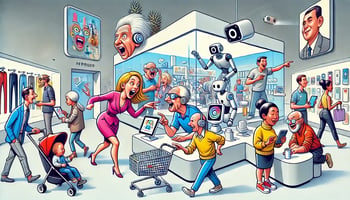Discover the top trends shaping the retail customer experience in 2024 and learn how to...
Adapting to a New Wave: Why Retailers Must Prioritise Older Shoppers


Discover the top trends shaping the retail customer experience in 2024 and learn how to...

The retail industry has undergone a significant transformation with the rise of digital...

Yael Selfin, vice chair and chief economist of KPMG, wrote a thought-provoking article in the London Times about demographic changes that mean more consumers are over 65, so businesses must adapt their customer service accordingly. It prompted me to think about the implications this has, particularly for retailers.
It's a new reality for retailers: the over-65 demographic is growing and set to become an even more significant force in the consumer market. People are living longer, healthier lives and stay active as consumers longer, too. Projections suggest that by the mid-2030s, people over 65 will outnumber children under 15 in many developed economies, with those over 80 reaching an impressive 265 million worldwide.
This shift has profound implications for how retailers approach customer experience. Older customers often have unique needs and priorities and won't settle for a one-size-fits-all approach. Here's how retailers can go beyond basic accessibility to enhance their experience, build loyalty, and stand out.
Personalised Assistance: Small Touches Make a Big ImpactOlder customers often appreciate and even expect thoughtful, personalised service. With more varied lifestyles, they may want different levels of support depending on the situation. For instance, customers might appreciate help carrying their shopping bags to the car or locating items that are harder to reach on higher shelves. Empowering employees to proactively offer assistance can turn a simple shopping trip into a memorable experience.
Take the example of a department store that introduced 'shop guides' – team members specifically trained to assist older shoppers with navigating the store or answering product questions. Not only did it make shopping more convenient, but customers also reported feeling valued and respected. These personalised interactions foster loyalty and bring customers back, time and again.
Rethink Layouts: Navigable and Inviting Store DesignsIn-store navigation is crucial for older customers. Aisles that are too narrow or crowded, excessive noise, or unclear signage can be frustrating or even hazardous. A simple reconfiguration, like widening aisles or adding more seating options for resting, can make a significant difference.
Imagine a supermarket layout that intuitively guides customers to key sections without needing constant wayfinding. Large, clear signs and product placements that don't require excessive bending or reaching make older shoppers feel more comfortable. Additions like sturdy benches or chairs throughout the store can encourage them to stay longer and explore, leading to more purchases.
Digital Solutions with a Human TouchMany older shoppers are keen to embrace technology but are often deterred by poorly designed interfaces. With online shopping becoming the norm, older customers need an intuitive digital experience that offers support when needed. This demographic shift suggests an opportunity for retailers to make online shopping accessible by simplifying navigation and offering live support – either through a helpline or video chats – when they encounter an issue.
For example, a clothing retailer created a phone line for online order support for older customers. They also added a "help" icon on their website to connect customers directly with a human representative rather than a chatbot. These solutions acknowledge that older shoppers may prefer human interaction over navigating complex online processes.
Clear Communication: Transparency MattersClear, transparent communication can make or break the experience for older customers. Many prefer detailed, honest product descriptions and pricing clarity, and they want packaging that doesn't require a magnifying glass to read. For instance, increasing font sizes on price labels and using clear, straightforward language on signage can make a store more user-friendly.
One pharmacy chain realised their small-print labels were a significant source of frustration for older customers. By increasing label font sizes and providing more detailed product information in larger type, they reduced customer confusion and complaints. This small change also communicated respect, showing that the brand listens to and values its older customers.
Building Loyalty through Community InitiativesMany older customers are looking for a sense of community and connection. Retailers can create a sense of belonging by organising in-store or online events – whether it's a senior shopping hour, a product demonstration, or even a gardening workshop. These efforts can be especially effective because they offer experiences that meet older customers' social needs, providing them with goods and memorable interactions.
For example, a grocery chain started hosting 'quiet hours' for seniors, with music turned down and staff on hand for extra assistance. Feedback showed that seniors felt more comfortable shopping during these times and often brought friends along, enhancing word-of-mouth marketing and solidifying the store's place in their routine.
The Business Case: Loyalty, Value, and Reputation
The business benefits of catering to older customers are evident. Not only is this demographic more likely to remain loyal to brands that make them feel respected and supported, but they're also more likely to spread the word about positive experiences. With reduced marketing costs and increased customer retention, retailers can enjoy the benefits of a customer base that genuinely feels at home in their stores.
In a competitive market, these adjustments accommodate older customers and give retailers a real edge. As the over-65 demographic continues to grow, companies that lead with empathy, adaptability, and respect will capture market share and the trust and loyalty of a powerful customer base that's here to stay.
If you would like an introductory conversation without obligation about how we can assist you in prioritising and implementing business improvements, please contact us at https://www.retailcx.ie/contact.